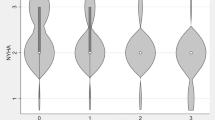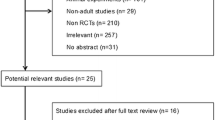Abstract
Aim
To investigate the haemodynamic response to and clinical safety and tolerability of intravenous esmolol (Brevibloc®, Baxter Healthcare Corporation, Deerfield, Illinois, USA) in elderly and younger patients with acute non-ST elevation myocardial infarction (NSTEMI) and heart failure.
Patients and methods
We studied 24 consecutive patients, 12 of them elderly (≥75 years old) and 12 younger (32–74 years old), with NSTEMI and symptoms of heart failure on presentation. After stabilisation of the patient’s condition with standard therapy, intravenous esmolol was administered. An infusion rate of 0.05 mg/kg/min for 30 minutes was instituted and, if no adverse effects developed, this was increased to 0.20 mg/kg/min. All haemodynamic parameters were measured before and at the end of each administration using a Swan-Ganz catheter.
Results
Only one patient in the elderly subgroup did not tolerate the augmented infusion rate (because of severe bradycardia) and so had to return to the initial lower infusion rate. The cardiac index (mean ± SD) was 2.4 ± 0.9 L/min/m2 at baseline and decreased to 1.9 ± 0.4 L/min/m2 (p < 0.05 vs baseline) at the end of the administration of the second dose of esmolol in the elderly patients and 2.6 ± 0.5 L/min/m2 and 2.2 ± 0.5 L/min/m2 (p < 0.05 vs baseline), respectively, in the younger patients. Mean pulmonary wedge pressure was 17 ± 6mm Hg at baseline and increased to 19 ± 4mm Hg (p < 0.05 vs baseline) at the end of the second dose of esmolol in the elderly patients and 16 ± 10mm Hg and 18 ± 10mm Hg (p < 0.05 vs baseline), respectively, in the younger patients. The response of both age groups to esmolol was the same for all of the parameters examined.
Conclusion
Intravenous esmolol was safe and well tolerated in the early phase of NSTEMI in patients presenting with symptoms of heart failure and ongoing ischaemia, regardless of their age.


Similar content being viewed by others
Notes
Conditions for which there is conflicting evidence and/or a divergence of opinion about the usefulness/efficacy of a procedure or treatment and the usefulness/efficacy is less well established by evidence/opinion.
Consensus opinion of experts.
Conditions for which there is conflicting evidence and/or a divergence of opinion about the usefulness/efficacy of a procedure or treatment and the weight of evidence/opinion is in favour of usefulness/efficacy.
Data derived from a single randomised trial or non-randomised studies.
The use of trade names is for product identification purposes only and does not imply endorsement.
References
Braunwald E, Antman EM, Beasley JW, et al. American College of Cardiology/American Heart Association Committee on the Management of Patients with Unstable Angina. ACC/AHA 2002 guideline update for the management of patients with unstable angina and non-ST-elevation myocardial infarction. Summary article: a report of the ACC/AHA task force on practice guidelines (Committee on the Management of Patients with Unstable Angina). J Am Coll Cardiol 2002 Oct 2; 40: 1366–74
Yusuf S, Peto R, Lewis J, et al. Beta blockade during and after myocardial infarction: an overview of the randomized trials. Prog Cardiovasc Dis 1985; 27: 335–71
Herlitz J, Elmfeldt D, Hjalmarson A, et al. Effect of metoprolol on indirect signs of the size and severity of acute myocardial infarction. Am J Cardiol 1983; 51: 1282–8
Nieminen MS, Bohm M, Cowie MR, et al. ESC Committee for Practice Guideline. Executive summary of the guidelines on the diagnosis and treatment of acute heart failure: the Task Force on Acute Heart Failure of the European Society of Cardiology. Eur Heart J 2005; 26: 384–416
Kyriakides ZS, Papaioannou G, Paraskevaidis IA, et al. Systolic functional response of normal older and younger adult left ventricles to β-blockade during exercise. Cardiovasc Drugs Ther 1995 Apr; 9(2): 289–94
Yin FC, Raizes GS, Guarnieri T, et al. Age-associated decrease in ventricular response to haemodynamic stress during beta-adrenergic blockade. Br Heart J 1978; 40: 1349–55
Ahmed A. Myocardial beta-1 adrenoceptor down-regulation in aging and heart failure: implications for beta-blocker use in older adults with heart failure. Eur J Heart Fail 2003; 5(6): 709–15
White M, Leenen FH. Effects of age on cardiovascular responses to adrenaline in man. Br J Clin Pharmacol 1997; 43(4): 407–14
White M, Roden R, Minobe W, et al. Age-related changes in beta-adrenergic neuroeffector systems in the human heart. Circulation 1994; 90(3): 1225–38
Feldman RD. Physiological and molecular correlates of age-related changes in the human beta-adrenergic receptor system. Fed Proc 1986; 45(1): 48–50
Lehmann M, Schmid P, Keul J. Age- and exercise-related sympathetic activity in untrained volunteers, trained athletes and patients with impaired left-ventricular contractility. Eur Heart J 1984; 5Suppl. E: 1–7
GISSI-3. Effects of lisinopril and transdermal glyceryl trinitrate singly and together on 6-week mortality and ventricular function after acute myocardial infarction: Gruppo Italiano per lo Studio della Sopravvivenza nell’infarto miocardico. Lancet 1994; 343: 1115–22
Barbier GH, Shettigar UR, Appunn DO. Clinical rationale for the use of an ultra-short acting beta-blocker: esmolol. Int J Clin Pharmacol Ther 1995; 33: 212–8
Grossman W. Blood flow measurement: the cardiac output. In: Grossman W, Baim DS, editors. Cardiac catheterization, angiography and intervention. 4th ed. Philadelphia (PA): Lea & Febiger, 1991: 105–22
Kyriakides ZS, Kremastinos D, Karavolias G, et al. Intravenous atenolol in elderly patients in the early phase of acute myocardial infarction. Cardiovasc Drugs Ther 1992; 6: 475–9
Randomised trial of intravenous atenolol among 16 027 cases of suspected acute myocardial infarction: ISIS-1. First International Study of Infarct Survival Collaborative Group. Lancet 1986; 2(8498): 57–66
Metoprolol in acute myocardial infarction: patient population. The MIAMI Trial Research Group. Am J Cardiol 1985; 56(14): 10G–14G
Hunt SA, Baker DW, Chin MH, et al. ACC/AHA guidelines for the evaluation and management of chronic heart failure in the adult: executive summary a report of the American College of Cardiology/American Heart Association Task Force on Practice Guidelines (Committee to Revise the 1995 Guidelines for the Evaluation and Management of Heart Failure). Circulation 2001; 104: 2996–3007
Gheorghiade M, Colucci WS, Swedberg K. β-blockers in chronic heart failure. Circulation 2003; 107: 1570–5
Olivetti G, Melissari Capasso JM, Anversa P. Cardiomyopathy of the aging human heart: myocyte loss and reactive cellular hypertrophy. Circ Res 1991; 68: 1560–8
White M, Leenen FHJ. Aging and cardiovascular responsiveness to β-agonist in humans: role of changes in β-receptor responses versus baroreflex activity. Clin Pharmacol Ther 1994; 56(5): 543–53
Xiao RP, Lakatta EG. Deterioration of β-adrenergic modulation of cardiovascular function with aging. Ann N Y Acad Sci 1992; 673: 293–310
Dillon N, Chung S, Kelly J, et al. Age and beta adrenoreceptor mediated function. Clin Pharmacol Ther 1980; 27: 769–72
Kyriakides ZS, Kelesides K, Melanidis J, et al. Systolic functional response of normal older and younger adult left ventricles to dobutamine. Am J Cardiol 1986; 58: 816–9
Rich MW, Imburgia M. Inotropic response to dobutamine in elderly patients with decompensated congestive heart failure. Am J Cardiol 1990; 65: 519–21
Podrazik PM, Schwartz JB. Cardiovascular pharmacology of aging. Cardiol Clin 1999; 17(1): 17–34
Proper R. Left ventricular stroke volume measurements not affected by chronologic aging. Am Heart J 1972; 83: 843–5
COMMIT Collaborative Group. Early intravenous then oral metoprolol in 45852 patients with acute myocardial infarction: randomized placebo-controlled trial. Lancet 2005; 366: 1622–32
Acknowledgements
No sources of funding were used to assist in the preparation of this article. The authors have no conflicts of interest that are directly relevant to the content of this study.
Author information
Authors and Affiliations
Corresponding author
Rights and permissions
About this article
Cite this article
Koutouzis, M., Nikolidakis, S., Grigoriadis, A. et al. Intravenous Esmolol is Well Tolerated in Elderly Patients with Heart Failure in the Early Phase of Non-ST Elevation Myocardial Infarction. Drugs Aging 23, 673–680 (2006). https://doi.org/10.2165/00002512-200623080-00004
Published:
Issue Date:
DOI: https://doi.org/10.2165/00002512-200623080-00004




